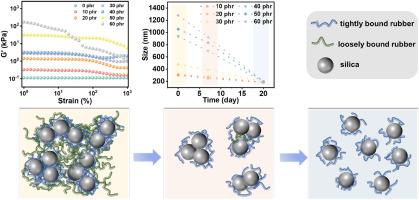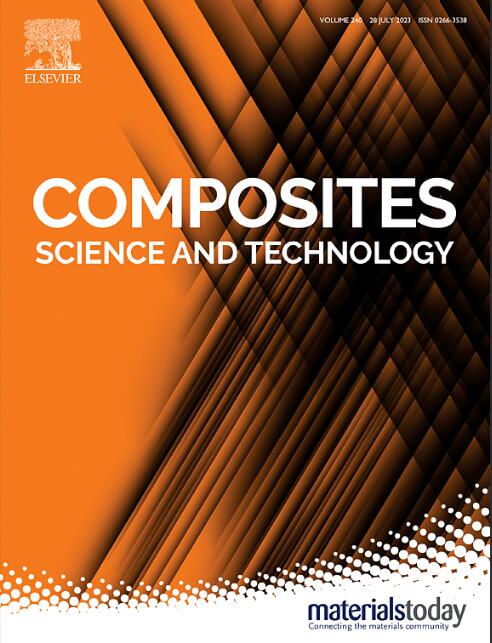Fraction-dependent filler network in silicone rubber: Unraveling abrupt enhancement in rheological properties via solvent extraction and DLS study
IF 8.3
1区 材料科学
Q1 MATERIALS SCIENCE, COMPOSITES
引用次数: 0
Abstract
A pivotal nanofiller network will be constructed by the filler loading threshold inside the silicone rubber, leading to abrupt enhancement in the rheological properties of the composites. However, the contribution of the nanofiller network to the performance mutation is poorly understood due to lack of direct evidence to recognize the formation of filler networks. This work quantitatively investigated the filler aggregation network of solvent-extracted monodisperse silica-filled polydimethylsiloxane (PDMS) composites to interpret the rheological properties. The results indicated that, when filler loadings reach 60 phr, the size of the filler network reaches its maximum (1280.5 nm), significantly increasing the storage modulus (166 kPa) and Payne effect (163 kPa), due to the formation of a filler network confirmed by Dynamic Light Scattering (DLS) and scanning electron microscope (SEM) observation. The reduction in aggregate size observed with longer extraction times is because of the collapse of the nanofiller network, which occurs as the polymer chains are removed. The aggregates reappear in a monodisperse form as the extraction duration reaches 20 days. This confirms that filler aggregates of interconnected polymer chains can form a well-developed network structure that effectively supports and transfers stresses. This contributes to an in-depth understanding of the formation mechanism of nanofiller networks, aiding the advancement of high-performance polymer nanocomposites.

硅橡胶中取决于馏分的填料网络:通过溶剂萃取和 DLS 研究揭示流变特性的突然增强
硅橡胶内部的填料负载阈值将构建一个关键的纳米填料网络,从而导致复合材料流变特性的突然增强。然而,由于缺乏识别填料网络形成的直接证据,人们对纳米填料网络对性能突变的贡献知之甚少。本研究定量研究了溶剂萃取单分散二氧化硅填充聚二甲基硅氧烷(PDMS)复合材料的填料聚集网络,以解释其流变特性。结果表明,当填料负载量达到 60 phr 时,填料网络的尺寸达到最大值(1280.5 nm),显著提高了存储模量(166 kPa)和佩恩效应(163 kPa),这是因为动态光散射(DLS)和扫描电子显微镜(SEM)观察证实了填料网络的形成。随着萃取时间的延长,观察到的聚合体尺寸减小,这是因为聚合物链被去除后,纳米填料网络发生了坍塌。当萃取时间达到 20 天时,聚集体重新以单分散形式出现。这证实了由相互连接的聚合物链组成的填料聚集体可以形成发达的网络结构,从而有效地支撑和传递应力。这有助于深入了解纳米填料网络的形成机理,从而推动高性能聚合物纳米复合材料的发展。
本文章由计算机程序翻译,如有差异,请以英文原文为准。
求助全文
约1分钟内获得全文
求助全文
来源期刊

Composites Science and Technology
工程技术-材料科学:复合
CiteScore
16.20
自引率
9.90%
发文量
611
审稿时长
33 days
期刊介绍:
Composites Science and Technology publishes refereed original articles on the fundamental and applied science of engineering composites. The focus of this journal is on polymeric matrix composites with reinforcements/fillers ranging from nano- to macro-scale. CSTE encourages manuscripts reporting unique, innovative contributions to the physics, chemistry, materials science and applied mechanics aspects of advanced composites.
Besides traditional fiber reinforced composites, novel composites with significant potential for engineering applications are encouraged.
 求助内容:
求助内容: 应助结果提醒方式:
应助结果提醒方式:


